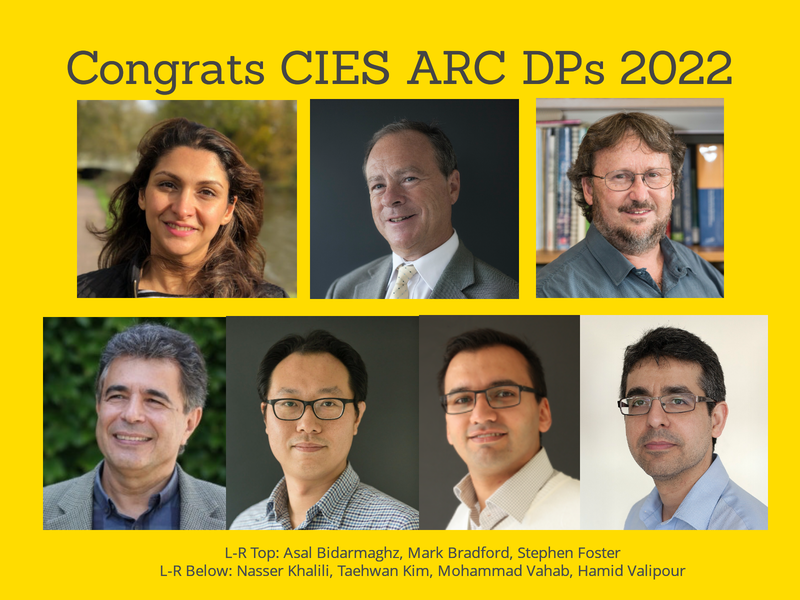CIES ARC Discovery Grants for 2022
The UNSW Centre for Infrastructure, Engineering and Safety (CIES) has begun 2022 on a very strong footing with seven academic staff successful in securing four new ARC Discovery Project (DP) grants commencing this year. Three of the DPs – with a total value of just over $1 million - are led and administered by CIES, and the fourth is led by colleagues at UTS. Congratulations to all involved for this outstanding achievement!
The successful grants are as follows (with CIES staff listed in bold):
DP220104021 - Non-differentiable Energy Minimisation For Modelling Fractured Porous Media.
- Investigators: Professor Nasser Khalili; Dr Mohammad Vahab; Dr Asal Bidarmaghz; Dr Mohammadreza Hirmand : Amount Awarded: $373,000
DP220101038 - Torsion in innovative timber composite floors.
- Investigators: A/Professor Hamid Valipour; Professor Mark Bradford: $340,000
DP220100841 - Connections for hybrid steel-timber-concrete structures.
- Investigators: A/Professor Hamid Valipour; Professor Stephen Foster: $318,000
DP220101051 - Self-Healing Concrete for Mitigation of Chloride Induced Steel Corrosion.
- Investigators: Professor Arnaud Castel; Dr Wengui Li; Dr Taehwan Kim: $220,000
About the Projects:
DP220104021: Non-differentiable Energy Minimisation for Modelling Fractured Porous Media.
- Professor Nasser Khalili; Dr Mohammad Vahab; Dr Asal Bidarmaghz; Dr Mohammadreza Hirmand
This project is aimed at advancing theoretical, computational and experimental bases for the fracturing of geomaterials, and providing scientists and engineers with much needed predictive tools for quantitative assessment of the responses. By incorporating previously neglected aspects such as energy minimisation, advanced constitutive modelling, and non-planar interacting fracture growth, confidence in the design and planning of engineering processes in fractured porous media will be increased to the point that costly over/under designs are avoided. Through the use of the tools developed, it will be possible to detect weaknesses in the design, assess the impact and implement effective measures to improve performance.
DP220101038: Torsion in innovative timber composite floors.
- A/Professor Hamid Valipour; Professor Mark Bradford:
Application of lightweight sustainably sourced timber panels combined with steel beams or reinforced concrete slabs in composite floors has the potential to significantly improve the speed and efficiency, and reduce the carbon and energy footprint of the construction industry. This project aims to produce world-first benchmark experimental data and advanced numerical and simple analytical models required for efficient, yet safe and reliable analysis and design of timber-concrete and steel-timber composite floors subjected to complex 3-dimensional loading scenarios that involve combinations of torsion, bending and shear.
The outcomes are expected to promote innovation and advance knowledge in the field of structural mechanics.
DP220100841: Connections for hybrid steel-timber-concrete structures.
- A/Professor Hamid Valipour; Professor Stephen Foster
Connections play a vital role in overall performance, reliability, and adaptability of civil structures. This project aims to develop innovative, easy to fabricate and efficient connections for hybrid structural systems that fully exploit advantages of steel, concrete and engineered timber to reduce the self-weight, cost and negative environmental impact, and enhance opportunities for deconstruction, reusing and upgrading of structures. Structural performance of the connections will be assessed by laboratory testing and advanced numerical modelling. Comprehensive knowledge on stiffness, strength, and ductility and world-first provisions for safe and cost-effective design of the hybrid steel-timber-concrete structures will be generated.
DP220101051: Self-Healing Concrete for Mitigation of Chloride Induced Steel Corrosion.
- Professor Arnaud Castel; Dr Wengui Li; Dr Taehwan Kim
This project aims to develop an intrinsic self-healing concrete using crystalline admixtures for rapid healing of concrete cracking. In marine environments, concrete cracking provides a direct access for chlorides from sea water to the steel reinforcement, leading to early and severe steel corrosion. The self-healing concrete will be designed to address the two main causes of concrete structures deterioration in Australia: early age cracking due to restrained shrinkage and chloride induced steel reinforcement corrosion. The outcomes of this project will drive the advances in developing and applying crystalline admixture-based self-healing concrete to extend the service life of concrete structures and avoid costly repair.




